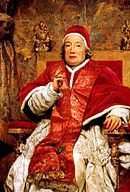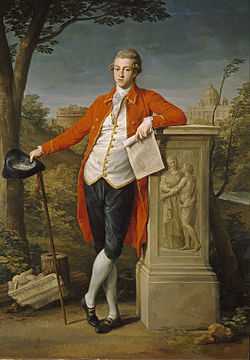Pompeo Batoni
| Pompeo Girolamo Batoni | |
|---|---|
 Pompeo Girolamo Batoni. Self portrait, 1773-1774. Galleria degli Uffizi, Florence | |
| Born |
25 January 1708 Lucca |
| Died |
4 February 1787 (aged 79) Rome |
| Spouse | Caterina Setti, Lucia Fattori |
| Nationality | Italian |
| Field | painter |
| Training | Agostino Masucci, Sebastiano Conca |
Pompeo Girolamo Batoni (25 January 1708 – 4 February 1787) was an Italian painter whose style incorporated elements of the French Rococo, Bolognese classicism, and nascent Neoclassicism.
Batoni aimed at overcoming the excesses and frivolities of the Rococo by taking inspiration in classical antiquity and in the work of artists such as Nicolas Poussin, and especially Raphael. As such he was a precursor of Neoclassicism.
Biography
He was born in Lucca, the son of a goldsmith, Paolino Batoni. He moved to Rome in 1727, and apprenticed with Agostino Masucci, Sebastiano Conca and/or Francesco Imperiali (1679–1740).
Batoni owed his first independent commission to the rains that struck Rome in April 1732. Seeking shelter from a sudden storm, Forte Gabrielli di Gubbio, count of Baccaresca took cover under the portico of the Palazzo dei Conservatori on the Capitoline Hill. Here the nobleman met the young artist who was drawing the ancient bas-reliefs and the paintings of the staircase of the palace. Impressed by his skill and the purity of the design, Gabrielli asked Batoni to see some of his works, and when conducted to the painter's studio he was so awed by his talent that he offered him to paint a new altarpiece for the chapel of his family in San Gregorio Magno al Celio, the Madonna on a Throne with child and four Saints and Blesseds of the Gabrielli family (1732–33).
The Gabrielli Madonna obtained general admiration and by the early 1740s Batoni started to receive other independent commissions. In 1741, he was inducted into the Accademia di San Luca. His celebrated painting, The Ecstasy of Saint Catherine of Siena (1743) [1] illustrates his academic refinement of the late-Baroque style. Another masterpiece, his Fall of Simon Magus[2] was painted initially for the St Peter's Basilica.
Batoni became a highly-fashionable painter in Rome, particularly after his rival, the proto-neoclassicist Anton Raphael Mengs, departed for Spain in 1761. Batoni befriended Winckelmann and, like him, aimed in his painting to the restrained classicism of painters from earlier centuries, such as Raphael and Poussin, rather than to the work of the Venetian artists then in vogue.
He was greatly in demand for portraits, particularly by the British traveling through Rome,[3][4] who took pleasure in commissioning standing portraits set in the milieu of antiquities, ruins, and works of art. There are records of over 200 portraits by Batoni of visiting British patrons.[5] Such "Grand Tour" portraits by Batoni came to proliferate in the British private collections, thus ensuring the genre's popularity in the United Kingdom, where Sir Joshua Reynolds would become its leading practitioner. In 1760 the painter Benjamin West, while visiting Rome would complain that Italian artists "talked of nothing, looked at nothing but the works of Pompeo Batoni".[6]
In 1769, the double portrait[7] of the emperor Joseph II and his brother Pietro Leopoldo I (then Grand Duke of Tuscany, later emperor Leopold II), won an Austrian nobility for Batoni. He also portrayed Pope Clement XIII and Pope Pius VI.[8]
According to a rumor, before dying in Rome in 1787, he bequeathed his palette and brushes to Jacques-Louis David, to whom, full of admiration for his Oath of the Horatii, Batoni would have confessed: "Only the two of us can call themselves painters".
From 1759 Batoni lived in a large house at 25, Via Bocca di Leone in Rome, which included a studio as well as exhibition rooms and a drawing academy. His late years were affected by declining health; he died in Rome in 1787 at the age of 79, and was buried at his parish church of San Lorenzo in Lucina. Batoni's last will executors were cardinal Filippo Carandini and James Byres, the Scottish antiquary, but the estate was insolvent and his widow was forced by the events to petition the Grand Duke of Tuscany for financial assistance, offering in exchange her husband's unfinished self-portrait, today at the Uffizi in Florence.
He was married twice, to Caterina Setti (died 1742) in 1729, and then to Lucia Fattori in 1747, and had twelve children; three of his sons assisted in his studio.
Criticism and exhibitions
Pompeo Batoni was among the most celebrated Italian painters in his day and his patrons and collectors included royals and aristocrats from all over Europe. His fame and reputation decreased over the 19th century until 20th-century scholars dedicated their critical attention to him and again revived his fame among the general public. Among them the following can be noted: the German Ernst Emmerling, the Englishmen John Steegman and Benedict Nicolson, the Italian Isa Belli Barsali, the American Anthony M. Clark and Edgar Peters Bowron.
The first exhibition devoted to Pompeo Batoni was held in his hometown Lucca in 1967, after which two other were organized in London and New York in 1982. He was again the subject of a major exhibition at the Museum of Fine Arts in Houston, the National Gallery in London, and the Ducal Palace in Lucca in 2007-2008.
Gallery
Portraits
-
.jpg)
Portrait of Frederick North, Lord North, 1753, National Portrait Gallery, London
-

Portrait of John Rolle Walter, c.1753, Royal Albert Memorial Museum, Exeter
-

Portrait of Clement XIII, 1758, Museo Nazionale del Palazzo di Venezia, Rome
-

Portrait of Richard Milles, 1758, the National Gallery, London
-

Portrait of Charles Crowle, 1762, The Louvre, Paris
-
Portrait of Augustus FitzRoy, 3rd Duke of Grafton, 1762, National Portrait Gallery, London
-

Portrait of John Montagu, Marquess of Monthermer, 1764, Boughton House, Northamptonshire
-

Portrait of General William Gordon, 1765–66, Fyvie Castle, Fyvie
-

Portrait of Philip Metcalfe, 1766–67, National Portrait Gallery, London
-

Portrait of Lady Mary Fox, later Baroness Holland, 1767
-

Portrait of William Cavendish, 5th Duke of Devonshire, 1768, Chatsworth House, Derbyshire
-

Portrait of Sir Gregory Page-Turner, 3rd Baronet, c.1768, Private collection
-

Portrait of the Grand Duke Leopold of Tuscany and his brother Emperor Joseph II, 1769, Kunsthistorisches Museum, Vienna
-

Portrait of Francis Basset on the Grand Tour in Rome, 1778, The Prado, Madrid
-

Portrait of Anthony Ashley-Cooper, 5th Earl of Shaftesbury, 1782, St Giles House, Wimborne St Giles, Dorset
-

Portrait of John V, King of Portugal
-

Portrait of Maria Anna of Austria, Queen of Portugal
Other subjects
-

Achilles at the Court of Lycomedes, 1745, oil on canvas, Galleria degli Uffizi, Florence
-

Diana & Cupid, 1761, oil on canvas, Metropolitan Museum of Art, New York
-
Samson and Delilah, 1766, oil on canvas, The Detroit Institute of Arts, Detroit
-

The Holy Family with St Elizabeth and the Infant St John the Baptist 1777 now in the Hermitage Museum, Saint Petersburg
-

The Sacred Family, Capitoline Museums, Rome
Footnotes
- ↑ "Ecstasy of Saint Catherine of Siena - at Museo di Villa Guinigi in Lucca". Wga.hu. Retrieved 2012-07-20.
- ↑ Fall of Simon Magus (1750) at Cleveland Museum of Art
- ↑ "Portrait of John Talbot". Getty.edu. 2009-05-07. Retrieved 2012-07-20.
- ↑ "Portrait of John Wodehouse". Oberlin.edu. Retrieved 2012-07-20.
- ↑ Christiansen 1982, pp. 39-41.
- ↑ Christiansen 1982, p. 40.
- ↑ Portrait of Emperor Joseph and his brother, Grand Duke Leopold, in Rome
- ↑ "Portrait of Pius VI". Mv.vatican.va. Retrieved 2012-07-20.
References and Further reading
- E. Peters Bowron and P. Kerber, Pompeo Batoni, Prince of Painters in Eighteenth-Century Rome (2008)
- Christiansen, Keith (1982). European Paintings; Notable Acquisitions. New York: Metropolitan Museum of Art.
- Clark, Antony M. (1985). Pompeo Batoni. Oxford: Phaidon Press. ISBN 0-7148-2341-4.
External links
| Wikimedia Commons has media related to Pompeo Batoni. |
- Pompeo Batoni in "A World History of Art"
- Apollo and Two Muses at the Wilanów Palace Museum
- UK National Portrait Gallery Images of Frederick North, 2nd Earl of Guilford, Augustus Fitzroy, 3rd Duke of Grafton, and Philip Metcalfe.
 "Batoni, Pompeo Girolamo". Encyclopædia Britannica (11th ed.). 1911
"Batoni, Pompeo Girolamo". Encyclopædia Britannica (11th ed.). 1911
|



